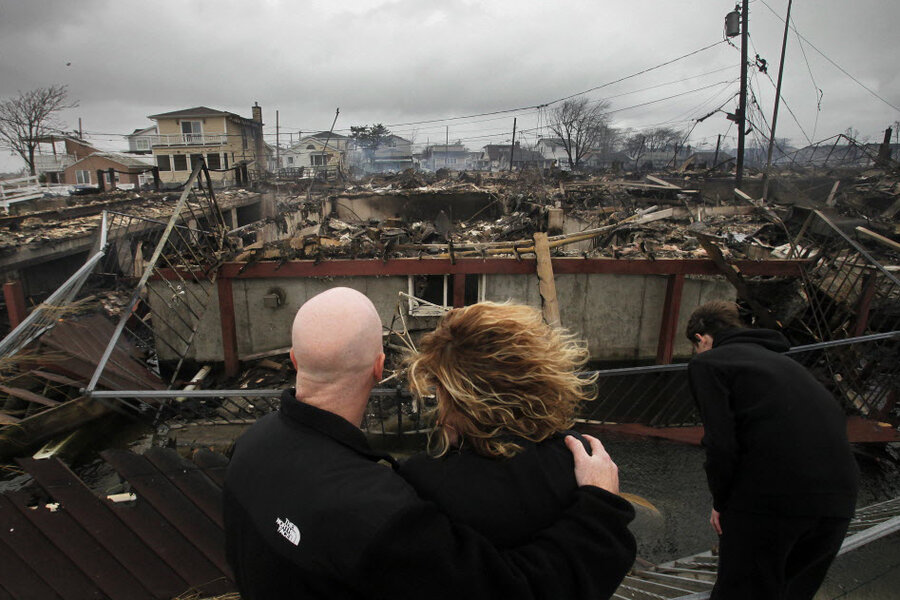Superstorm Sandy racks up $32 billion in NY damages
Loading...
| Albany, N.Y.
Top political leaders in New York put their heads together Monday on big requests for federal disaster aid as Gov. Andrew Cuomo announced that Superstorm Sandy ran up a bill of $32 billion in the state and the nation's largest city.
The cost is for repairs and restoration and does not include an additional accounting of over $9 billion to head off damage in the next disastrous storm, including steps to protect the power grid and cellphone network.
"It's common sense; it's intelligent," Cuomo said. "Why don't you spend some money now to save money in the future? And that's what prevention and mitigation is."
New York Mayor Michael Bloomberg had announced earlier in the day that Sandy caused $19 billion in losses in New York City — part of the $32 billion estimate Cuomo used.
New York taxpayers, Cuomo said, can't foot the bill.
"It would incapacitate the state. ... Tax increases are always a last, last, last resort."
Cuomo met with New York's congressional delegation to discuss the new figures and present "less than a wish list." The delegation, Cuomo and Bloomberg will now draw up a request for federal disaster aid.
States typically get 75 percent reimbursement for the cost of governments to restore mass transit and other services after a disaster.
The most basic recovery costs for roads, water systems, schools, parks, individual assistance and more total $15 billion in New York City; $7 billion for state agencies; $6.6 billion in Nassau County and $1.7 billion in Suffolk County, both on suburban Long Island; and $527 million in Westchester County and $143 million in Rockland County, both north of New York City, according to a state document used in the private briefing of the delegation and obtained by The Associated Press.
Hard times were already facing the state and city governments that were staring at deficits of more than $1 billion before Sandy hit in late October. State tax receipts have also missed projections, showing a continued slow recovery from a recession that could hit taxpayers in the governments' budgets this spring. And there's the looming fiscal cliff, the combination of expiring federal tax cuts and major spending cuts that could rattle the economy.
"Make no mistake, this will not be an easy task, particularly given the impending fiscal cliff, and a Congress that has been much less friendly to disaster relief than in the past," Schumer said. "We will work with the (Obama) administration on supplemental legislation, to be introduced in the upcoming December session of Congress, that will set us on the road to meeting New York's needs. This will be an effort that lasts not weeks, but many months, and we will not rest until the federal response meets New York's deep and extensive needs."
Rep. Peter King, a Long Island Republican who, like Schumer, is a powerful member of his chamber, said he is seeking cooperation from House leaders to find enough disaster aid.
"It really is survival," King said. "This is an emergency. This should be separate of all the debate about the fiscal cliff and everything else."
The Cuomo administration has gained the public support of President Barack Obama and FEMA in New York's proposal for full reimbursement for storm damage, but state officials have privately worried about how much the state can get now.
In the city, Bloomberg is asking federal lawmakers to put up nearly $10 billion to reimburse government agencies and private businesses. That would be additional funding on an expedited basis over the $5.4 billion in standard disaster aid that the city projects it will receive from the Federal Emergency Management Agency.
That FEMA money and private insurance won't cover all the public and private expenses from the storm, which included damaged streets and restaurants closed because of flooding, Bloomberg said.
"While the impact of the storm will be felt for some time and the challenges are great, I am confident that the city will rebound and emerge stronger than ever," Bloomberg wrote to the congressional delegation.
Reinsurance company Swiss Re showed the extent of private sector pain. It estimates that claims stemming from Sandy will cost the company about $900 million and that total losses from insured damage will be between $20 billion and $25 billion.
Reinsurance firms provide coverage to insurance companies for great losses stemming from events like natural disasters.
Other states are seeking federal assistance, too. FEMA has already paid out nearly $250 million in New Jersey, where Gov. Chris Christie says the preliminary damage estimate is $29.4 billion and could rise.
Associated Press writers Jennifer Peltz and Meghan Barr in New York City contributed to this report.





